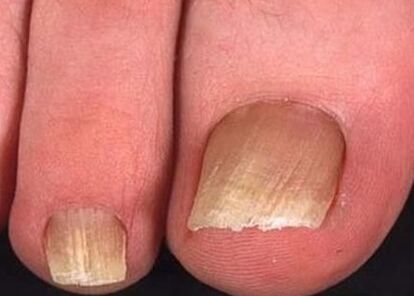
A healthy nail should look good - be smooth and even.Its color should be beige or slightly pink, which is due to the presence of blood vessels below it.When defects occur, the nail may lose normal color, turn dark or painted in different colors.When the thickness changes, the nails become misunderstood and look slot.In some diseases, nail plates can be deformed until they are disappeared.
Development abuses can be both congenital and acquired.In the first case, this is due to damage to the ectoderm-phabrial predisposing of the nail.It seems like deformation of the nail or its absence immediately after the birth of a child.
The vices acquired can develop for various reasons.The most common problem is the fungus, which in one form or another is present in every third person.The fungus can be not only external, in which only the plate is affected, but also from the internal - the tissue of the finger can be affected by their subsequent destruction.
In addition, such diseases can lead to a step -by -over -deformation:
- Psoriasis - With this pathology, the nail thickness changes.It becomes less than usual and unpleasant to the touch.In addition, pain develops - with palpation, discomfort is felt.The multi -colored spots develop under the plate - from red to purple - this shows bleeding.When the infection is joined, a hematomas under the nail can be observed.Local skin troops can be observed - cavities are formed in these places, which give their hands an endless appearance.The more current development of the disease can lead to onycholysis.
- Eczema is often accompanied not only by local defeat, but also by a summary.That is, in addition to damage to the plates, skin symptoms can also be observed.Eczema is manifested by changes in the nail roller and plate directly.Finger tissues become swollen, peeling can develop.The affected surface itching and pain.At the same time, the nail becomes boring and pale, stratification or Brittate is possible.
In addition to these causes, deformity can be provoked by a fungal nail infection.
The fungus is a disease that can casually lead to complete destruction of the plate.At the initial stage, this is manifested only by changing color and thickening, at the end the lesion leads to loss of nails.
Signs of infection with a fungus

When the onychomycosis infection, there is no intense acute pain and damage - therefore people often prefer not to notice it.In addition, the fungus at its early stage does not manifest itself from pronounced changes in the nails and is difficult to distinguish.
First of all, itching of the skin of the feet appears.It is intense and can be distracted from work or rest.It is caused by the spread of microorganisms in the dermis, which is perceived by the body as irritation.With constant itching, one can be disturbed by sleep and appetite.When meeting the skin, it is likely to bring bacteria into micro -cracks, then annexation of a secondary infection will develop.
If no treatment measures are taken, then organic changes in the nails and tissues occur.The plate becomes muddy and opaque, spots and stripes develop on it, which can light and dark - depends on the pathogen.
The change in the shade indicates that the yeast sponge completely captures the tissue of the plate.Often the color turns yellow, but it can also appear brown and white.
The fastness and fragility of the nails also show the fungal process.At the same time, the nails are separated, become misunderstood.Therefore, painful damage or defrosting the nail from his bed may occur in the event of injury.
If all these symptoms occur, or at least one of them, you should consult a doctor about treatment - without this the disease can go into chronic form.
Stages of development of infection
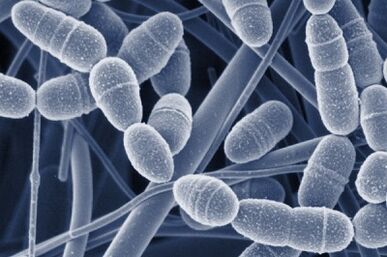
Unlike many pathologies, nail sponge is a slowly developing disease.It is characterized by a gradual flow, which is difficult to miss.The therapy of the fungus is effective at an early stage, therefore, the earlier the aid is provided, the better.
The initial stage is often not visually manifested.Therefore, it is impossible to show how the fungus of the toenails in the legs in the initial stage looks.But the first symptoms already appear at this point.Anxious bell in connection with the fungus is intense itching of the skin, which increases throughout the day and reaches the largest intensity at night.The only sign that can be the subject of the idea of a fungal infection is the appearance of a pathological color of the nails-this is manifested by the development of spots and stripes from pale yellow to white.There may be dark areas.
The stage of the normotrophic lesion is manifested by moderate symptoms.This is evidenced by the fact that the nail is not yet thickened and the expressed deformation is not observed in it.However, spots and stripes become extremely clear and visible to others.In addition, the unpleasant odor that comes from the legs joins.If you do not start treatment, the disease will inevitably go to the last stage.
With hypertrophic lesion, there is a thickening of not only the plate itself but also the surrounding tissues.This is manifested by deformation of the nail, can change the direction of growth, break down and break even with a slight effect on it.As a result, the nail can be reduced at its place in a severe course of the disease, the new plate does not grow.
In the presence of an accompanying pathology, the transition from the first stage to the launch occurs extremely quickly, in just a few weeks.This can happen due to the presence of immunodeficiency, cancer and weakness of the body, which develops in the elderly.
Injections in adults also cause the development of the disease.This can be a direct damage to the nail as well as the surrounding tissues, when the nail metabolism changes due to blood circulation.At that time, ideal conditions for a fungus were created.
With obesity and diabetes mellitus, the fungus of the toenails develops in 95 cases of 100. This is due to the fact that fungal microorganisms receive a lot necessary for the growth and reproduction of substances - such as glucose and lipids.Therefore, in such patients, pathology is extremely difficult.
Nail fungus when infected with dermatophytes
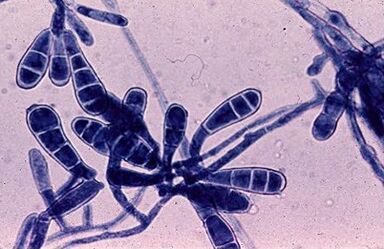
Dermatophytes are the most common cause of pathology.Infection is quite simple - through ordinary towels, showers or even internal slippers.
This type of fungus has two dangerous representatives that can equally cause fungal lesions - it is Trichophyton Rubrum and Trichophyton Mentagrophythes.
The first representative begins to penetrate the nails from its free edge, while moving further.Signs of infection with this fungus - a change in the color of the toenails with pink to yellow with black crossed, the texture of the plate worsens - it becomes fragile and fragile, decayed with physical exposure.
For an accurate diagnosis, you need to know what the nail fungus looks like.The most characteristic feature is the appearance of a detachment of the nail near its lateral edge.In this space, the accumulation of dirt occurs, which is favorable to the development of microorganisms.During this period, it is still possible to get rid of fungi without nail loss, just using ointments and creams in parallel with antifungal pills.
There is a so -called distal form of the disease, which is manifested since the onset of the nail lesion.This form is much more common, because in order to penetrate there, the microorganism is necessary for the entrance gate - a micropocker or other damage.This situation is not uncommon after a injury.With this option, it is necessary to remove the nail plate completely, as any conservative treatment will be ineffective.
If the cause of the fungus is Trichophyton Mentagrophytes, then the signs of the disease will be as follows:
- Thickening - there will be significant hypertrophy of the plate with the presence of deformities and defects of the tissue;
- The color of the plate becomes intense yellow, with a copper shade;
- An abscess of the finger near the nail appears;
- In the late stage, the skin lesion also joins - peeling and cracking of the skin is observed in interdigital gaps;
- The appearance of white bands and spots develops - these are the places where the fungus parasitizes most intensively;
- In hand, this type of pathogen never parasitizes.
In order to get rid of this fungus, it is necessary to undergo the right complete treatment with both oral medicines and local medicines - gels and ointments.
In severe cases, you may need to remove the nail and laser cleaning to remove the microorganisms.This method has many positive reviews.It is forbidden to use varnish.
Changes in the nail when they are infected with a sponge of the genus
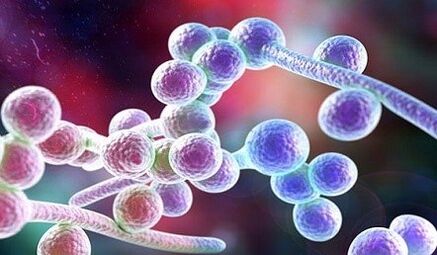
This disease is characterized by damage not only of the tissues on the limbs, but also by the location of the brush.The leading hand is more often affected, for example, the right hand is the right hand.From frequent contact with water, the disease progresses faster.
A characteristic characteristic of this disease is damage to the nail from the box.Over time, more tissues are captured - first the cell division area and then the free edge.
In this disease, more often than the rest, a secondary infection occurs.Candidiasis is accompanied by pain in the roller and bed, with palpation it is possible to release serous or purulent discharge.
The nail is gradually deformed and rises above the skin, its thickness can reach several millimeters.At the same time, the nail becomes the wave that is manifested by the presence of so -called combs, which can go in different directions.However, in candidiasis, the most common form of nail damage is exactly horizontal blackening.
In severe pathology, the nail is gradually separated from the bed of the nails, this is accompanied by discomfort and pain.In the case of accidental injury to such a nail, it is possible, accompanied by significant bleeding.The surface of the wound in this case slows down for a long time.
If the fungus affects the free edge of the nail, then this is often combined with skin or generalized shape.It's called distal.This variant of the course of the disease goes more difficult and is more difficult to treat.Distal form indicates that human immunity is weakened and influenced by microorganisms.
The treatment of candidiasis differs in different forms and stages of the disease.At first you can try to influence the microorganism with the help of local agents, but with a generalized or rapidly progressive form, you should take systemic oral medicines.In addition, if there are signs of major fungal damage, it is necessary to prescribe a complete medical examination for the search for diseases that have reduced the level of immunity.
Changes in the nail with a mold damage
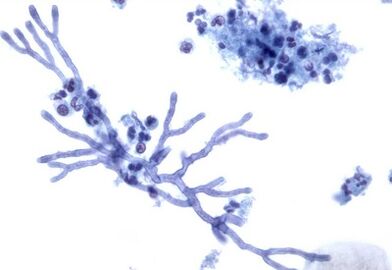
The lesion of mushrooms is more common than other pathogens.This is due to the fact that a person is not so common in contact with this type of microorganism because of their specificity.Most often, these mushrooms are infected against the background of an existing lesion.The most loved colony to which the form is joined are Trichophyton Mentagrophytes.Against this background, you can often see the combined effects of both mushrooms and bacteria.
This disease is characteristic of the elderly.During this period, there is a decrease in cellular immunity and the weakening of the body, which is why mushrooms develop more intensively.
The characteristic characteristic of these pathogens is their selectivity.They do not affect the skin and soft tissues, localized exclusively on the nails.
Among the causative agents, the most species are found:
- Alternaria - This fungus determines the development of nail deformity and hyperkeratosis.In order to recover from this disease, it is necessary to remove the nail plate, as the microorganisms are extremely deep in the tissue and it is quite difficult to eliminate them.
- Scytalidium dimidiatum - most often such microorganisms occur in patients with diabetes.In order to get rid of such a fungus, it is necessary to carefully monitor the level of glucose in the blood and to monitor in parallel with the endocrinologist.
- Scopulariopsis Brevicaulis is more common in public places, such as baths, swimming pools, showers.When localized in the nails, there is a change in their color from pink to white.
- Fusarium is common in rural areas, it is much in the ground from which it can easily switch to fabric.This fungus, when penetrates the body, can cause mycosis of internal organs, which is very difficult to treat.Therapy for such a terrible disease should only be performed in the hospital, as treatment is serious enough for the patient.
Therapy for mold damage is very complicated as it is necessary to treat the body from several colonies of microorganisms.A combination of antibiotics and antifungal drugs is used to get a lot of high quality therapy.In severe cases, they are not used orally, but intravenously.















